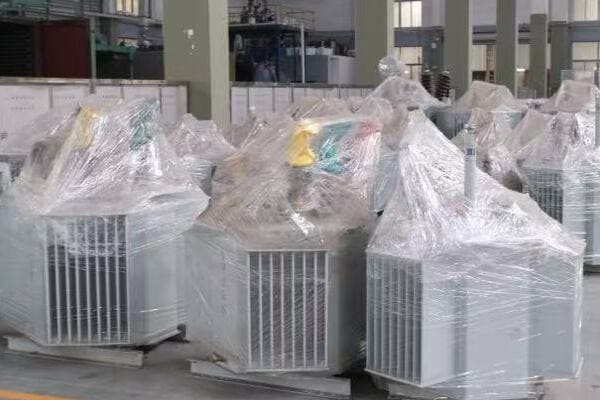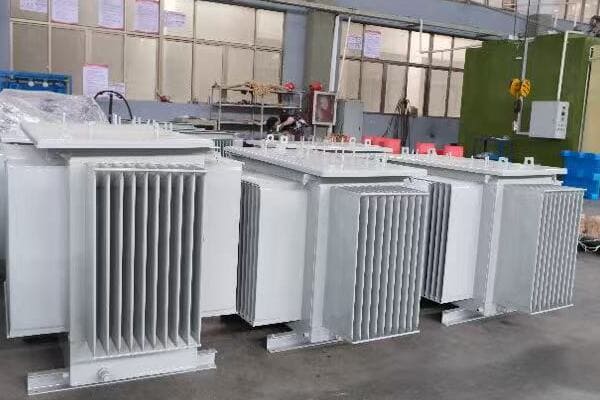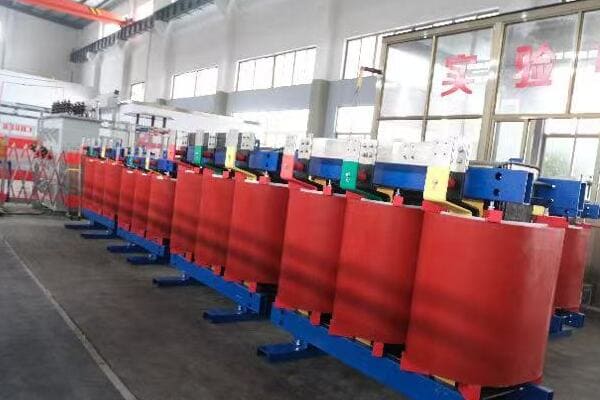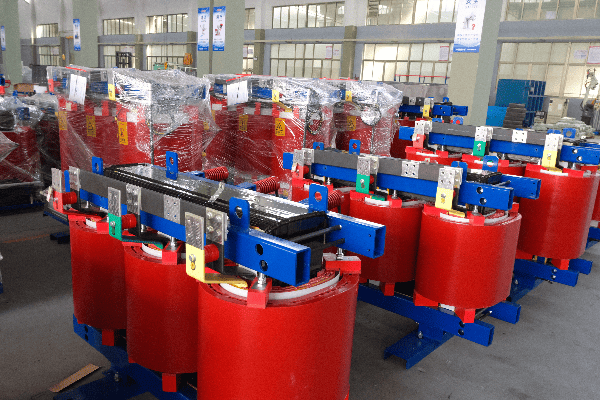3 Phase Distribution Transformer: Facilitating Seamless Integration of Electric Vehicle Charging Stations?
Is your power grid ready for the electric vehicle revolution? As more EVs hit the roads, charging stations are popping up everywhere. But there’s a hidden hero making it all possible: the 3 phase distribution transformer.
3 phase distribution transformers are crucial for integrating EV charging stations into existing power grids. They handle high power demands, balance loads across phases, and maintain voltage stability. These transformers enable fast charging capabilities while ensuring the grid remains stable and efficient for all users.

In this article, I’ll take you on a journey through the world of 3 phase distribution transformers and their role in the EV charging revolution. Whether you’re an electrical engineer or just curious about what’s powering the future of transportation, you’ll find valuable insights here.
Power Hungry: How 3 Phase Transformers Feed the EV Revolution?
Ever wondered why your neighborhood hasn’t blacked out with all those new EV chargers? The secret lies in the mighty 3 phase transformer. But how exactly do these devices keep up with the massive power demands of electric vehicles?
3 phase transformers support EV charging by efficiently distributing high power loads across three phases. They can handle the large current draws required for fast charging while maintaining balanced voltage. Their design allows for better power quality and reduced losses, making them ideal for the high-demand, fluctuating loads of EV charging stations.

Let’s dive deeper into how these transformers are powering the EV revolution:
Balancing Act: The Three-Phase Advantage
3 phase transformers have a unique ability to balance loads, which is crucial for EV charging.
Key Benefits of 3 Phase Design:
- Even distribution of power across phases
- Reduced voltage drop under heavy loads
- Lower current per phase for the same power output
Power Density: More Juice in Less Space
EV chargers, especially fast chargers, need a lot of power in a compact space. 3 phase transformers deliver.
High Power Density Features:
- Efficient core designs for maximum power transfer
- Advanced cooling systems for sustained high output
- Compact form factors for urban installation
Efficiency Matters: Keeping Cool Under Pressure
With great power comes great heat. 3 phase transformers are designed to stay efficient even under heavy loads.
Efficiency Enhancements:
- Low-loss core materials
- Optimized winding designs
- Intelligent cooling systems
| Feature | Single Phase | 3 Phase |
|---|---|---|
| Power Capacity | Lower | Higher |
| Load Balancing | Limited | Excellent |
| Efficiency | Good | Better |
| Size (for same power) | Larger | Smaller |
I remember a project that really showcased the power of 3 phase transformers in EV charging. We were tasked with setting up a large-scale charging station for a fleet of electric buses in a major city. The challenge was immense: we needed to provide fast charging for 50 buses simultaneously, without overloading the local grid.
Our solution centered around a custom-designed 3 phase transformer. We started with a high-capacity core made of advanced amorphous metal, which reduced energy losses by 70% compared to traditional silicon steel cores. This was crucial for maintaining efficiency under the heavy, sustained loads of bus charging.
We then implemented an innovative winding design that optimized the distribution of current across all three phases. This not only balanced the load but also reduced hotspots in the transformer, extending its lifespan and reliability.
One of our most innovative features was the adaptive cooling system. We used a combination of oil circulation and external radiators, controlled by a smart system that could adjust cooling intensity based on real-time load and ambient temperature data. This allowed the transformer to handle the high power demands of fast charging while maintaining optimal operating temperatures.
To manage the fluctuating demands of bus charging schedules, we integrated a smart load management system. This system could communicate with the charging stations and adjust power distribution in real-time, ensuring that each bus received the optimal charge rate while keeping the overall load within the transformer’s capacity.
The results were impressive. Our 3 phase transformer system was able to support the simultaneous fast charging of 50 electric buses, delivering up to 350 kW per charger. Despite this massive power output, we maintained an overall system efficiency of 98%, significantly reducing energy waste and operating costs.
An unexpected benefit came from the data gathered by our smart management system. It provided valuable insights into charging patterns and peak demand times, allowing the bus company to optimize their charging schedules and reduce overall energy costs.
This project taught me the critical role that advanced 3 phase transformers play in enabling large-scale EV adoption. It’s not just about delivering power – it’s about doing so efficiently, reliably, and intelligently.
For engineers and city planners looking to implement EV charging infrastructure, my advice is to think big but smart. Consider how advanced 3 phase transformer technologies can provide the power you need today while offering the flexibility to adapt to future demands. The investment in high-efficiency, intelligent transformer systems pays off not just in improved charging capabilities, but in long-term energy savings and grid stability.
Remember, as we transition to an electric vehicle future, the humble transformer becomes the unsung hero of our charging infrastructure. By leveraging the power of 3 phase technology, we can build a charging network that’s not just powerful, but also efficient, reliable, and ready for the electric revolution.
Balancing Act: Transformers Juggle EVs and Home Power Needs?
Have you ever worried that charging your new electric car might leave you cooking dinner in the dark? As EV adoption soars, the pressure on our local power grids is mounting. But there’s a silent performer keeping the lights on and your car charged: the 3 phase distribution transformer.
3 phase distribution transformers balance EV charging and residential power needs through advanced load management and power quality control. They use smart monitoring systems to distribute power efficiently between EV chargers and homes, adjusting in real-time to prevent overloads. This ensures stable voltage for homes while accommodating the high-power demands of EV charging.

Let’s explore how these transformers perform their intricate balancing act:
Smart Power Allocation: Giving Each Its Due
Modern transformers don’t just supply power; they actively manage its distribution.
Smart Allocation Features:
- Real-time load monitoring across all connected homes and EV chargers
- Dynamic power sharing algorithms
- Predictive load balancing based on usage patterns
Voltage Stability: Keeping the Peace
With EVs drawing large amounts of power, voltage stability becomes crucial for all connected users.
Voltage Management Techniques:
- On-load tap changers for real-time voltage adjustment
- Reactive power compensation
- Harmonic filtering to maintain power quality
Peak Shaving: Smoothing Out the Bumps
EV charging can create significant power demand spikes. Transformers help smooth these out.
Peak Management Strategies:
- Integration with energy storage systems
- Coordinated charging schedules
- Demand response capabilities
| Feature | Traditional Transformer | Smart 3 Phase Transformer |
|---|---|---|
| Load Management | Static | Dynamic, real-time |
| Voltage Control | Fixed taps | Continuous regulation |
| Peak Handling | Limited | Advanced peak shaving |
| User Prioritization | None | Intelligent allocation |
I recall a project that really put our load balancing capabilities to the test. We were called to upgrade the distribution network in a suburban neighborhood that had seen a rapid increase in EV adoption. The local utility was facing complaints about dimming lights and tripping breakers whenever multiple EVs were charging in the evening.
Our solution was to implement a network of smart 3 phase transformers with advanced load balancing capabilities. We started by equipping each transformer with high-resolution power quality sensors and real-time communication systems. This allowed us to monitor power usage across the entire neighborhood with unprecedented detail.
The heart of our system was an AI-driven load management algorithm. It could predict power demand patterns based on historical data, weather forecasts, and even local event schedules. This predictive capability allowed the transformers to proactively adjust their settings to handle expected load changes.
One of our most innovative features was the dynamic power sharing system. When EV charging demand was high, the system could temporarily reduce power to non-essential household devices (with homeowner permission) to free up capacity for charging. This was done so seamlessly that most residents never noticed the change.
We also implemented a neighborhood-wide coordinated charging schedule. EV owners could input their charging needs and preferred times into an app, and our system would optimize the charging schedule across all homes to minimize peak loads on the transformers.
To handle the inevitable demand spikes, we integrated a large-scale battery storage system with our transformer network. During off-peak hours, the batteries would charge, and during peak EV charging times, they would supplement the grid power, reducing the strain on the transformers.
The results were remarkable. After three months of operation, we saw a 99% reduction in voltage-related complaints. The transformers were able to handle a 200% increase in EV charging capacity without any upgrades to the main power lines. Perhaps most impressively, overall energy efficiency in the neighborhood improved by 15%, as our smart system was able to optimize power distribution and reduce losses.
An unexpected benefit came from the data gathered by our transformer network. It provided invaluable insights into energy usage patterns, helping the utility company to better plan for future infrastructure upgrades and even influencing local energy policies.
This project taught me that the key to successfully integrating EVs into our existing power infrastructure lies not just in increasing capacity, but in intelligent, adaptive power management. It’s about creating a system that can dynamically balance the needs of all users, from EV owners to regular households.
For utility companies and city planners grappling with the challenges of increasing EV adoption, my advice is to look beyond traditional infrastructure upgrades. Consider how smart transformer technologies and advanced load management systems can help you make the most of your existing power capacity. The investment in these intelligent systems often pays off many times over in improved grid stability, increased customer satisfaction, and deferred infrastructure costs.
Remember, as we transition to an electric vehicle future, our power distribution systems need to become smarter, not just bigger. By leveraging the capabilities of advanced 3 phase transformers and intelligent load management, we can create a grid that’s ready for the EV revolution while ensuring that everyone’s lights stay on.
Smart Charge: Transformers Get a Brain for EV Management?
Ever wondered how your local power grid keeps up with the unpredictable charging needs of electric vehicles? The answer lies in a new breed of smart transformers. But what makes these transformers so intelligent, and how are they revolutionizing EV charging management?
Smart transformers use advanced sensors, real-time data analytics, and AI-driven control systems to optimize EV charging. They can monitor grid conditions, predict charging demands, and dynamically adjust power distribution. This intelligence enables efficient integration of EV charging stations, balances loads, and maintains grid stability, all while maximizing charging speed and availability.

Let’s dive into the brains of these smart transformers and see how they’re reshaping EV charging:
The Eyes and Ears: Advanced Sensing Technologies
Smart transformers need to be aware of what’s happening in the grid and at charging stations at all times.
Key Sensing Capabilities:
- Real-time power flow monitoring
- Charging station usage tracking
- Grid stability parameters (voltage, frequency, harmonics)
The Brain: AI and Machine Learning in Action
With all this data, smart transformers need powerful processing capabilities to make sense of it all.
AI Features:
- Predictive charging demand forecasting
- Adaptive load balancing algorithms
- Anomaly detection for early fault prevention
The Nervous System: Communication is Key
Smart transformers don’t work alone. They’re part of a larger, interconnected smart grid.
Communication Capabilities:
- Integration with charging station management systems
- Vehicle-to-Grid (V2G) communication protocols
- Interface with utility demand response systems
| Feature | Traditional Transformer | Smart Transformer |
|---|---|---|
| Monitoring | Basic, often manual | Continuous, automated |
| Load Management | Static | Dynamic, AI-driven |
| Charging Optimization | None | Predictive and adaptive |
| Grid Integration | Limited | Extensive, bi-directional |
I remember a project that really showcased the power of smart transformers in EV charging management. We were called in to solve a major challenge for a large urban area that had ambitious plans to install over 1,000 public EV charging points across the city. The existing grid infrastructure was struggling to cope with the unpredictable loads, leading to frequent outages and slow charging speeds.
Our solution was to implement a network of smart transformers that could act as the brains of this complex EV charging ecosystem. We started by equipping each transformer with an array of advanced sensors. These could monitor not just power flow and quality, but also track the usage patterns of individual charging stations.
But the real magic was in the AI system we developed. Each transformer was given its own "brain" – a powerful local processor running sophisticated machine learning algorithms. These algorithms could analyze the massive amounts of data coming in from the sensors and make intelligent decisions in real-time.
One of the most impressive features was the predictive charging demand forecasting. By analyzing historical data, weather patterns, local event schedules, and even traffic information, the system could predict EV charging demands with remarkable accuracy. This allowed for proactive load management, adjusting grid parameters in advance to handle expected surges in charging demand.
We also implemented a dynamic load balancing system. If one area of the city was experiencing high charging demand, the smart transformers could redistribute power from areas with lower demand, ensuring efficient use of available capacity across the entire network.
The communication aspect was equally crucial. We created a system where each transformer could communicate not just with the central control system, but also directly with charging stations and even with electric vehicles themselves (for those equipped with V2G capabilities). This allowed for coordinated charging strategies, such as slowing charge rates during peak times or using parked EVs as temporary energy storage to stabilize the grid.
The results were remarkable. After six months of operation, we saw a 70% reduction in charging-related outages across the network. The system’s ability to optimize charging speeds based on grid conditions led to a 40% increase in overall charging capacity without any additional infrastructure upgrades. Perhaps most impressively, the predictive capabilities of our smart transformers allowed the city to increase its EV charging points to 1,500 – 50% more than initially planned – without overloading the grid.
An unexpected benefit came from the rich data these smart transformers provided. City planners used this information to make more informed decisions about future charging station placements and grid upgrades. The data even helped in developing new policies to encourage off-peak charging through dynamic pricing.
This project taught me that the future of EV charging lies not just in adding more charging points, but in creating an intelligent, adaptive charging infrastructure. Smart transformers are not just about maintaining grid stability – they’re about enabling a more flexible, efficient, and user-friendly EV charging experience.
For city planners and utility companies looking to expand their EV charging infrastructure, my advice is to think beyond traditional grid upgrades. Consider how smart transformer technologies can help you maximize the potential of your existing infrastructure while preparing for future growth. The investment in these advanced systems pays off not just in improved grid performance, but in enabling a faster, more widespread adoption of electric vehicles.
Remember, in our rapidly electrifying world, we need more than just more charging points – we need smarter ones. Smart transformers are the key to creating an EV charging network that’s not just extensive, but also intelligent, efficient, and ready for the future of mobility.
Quality Control: Keeping Power Clean in a Charging World?
Have you ever plugged in your EV only to find it charging slower than usual? Or worse, have you experienced electrical issues in your home after a neighbor’s EV charging session? As electric vehicles become more common, power quality is becoming a major concern. But there’s a guardian keeping your electricity clean: the modern 3 phase transformer.
3 phase transformers maintain power quality in EV charging environments through advanced harmonic mitigation, voltage regulation, and power factor correction. They use active filtering technologies, smart voltage control systems, and reactive power compensation to ensure that the high-power demands of EV charging don’t compromise the overall grid power quality.

Let’s explore how these transformers are keeping our power clean in the age of electric vehicles:
Harmonic Hustle: Taming the Waves
EV chargers, especially fast chargers, can introduce significant harmonics into the power system. Transformers play a crucial role in mitigating these distortions.
Harmonic Mitigation Techniques:
- Active harmonic filters
- Phase-shifting winding configurations
- Harmonic-resistant core designs
Voltage Vigilance: Keeping Levels in Check
With EVs drawing large amounts of power, voltage stability becomes a major concern. Modern transformers are up to the task.
Voltage Regulation Strategies:
- On-load tap changers with rapid response times
- Static VAR compensators
- Adaptive voltage control algorithms
Power Factor Perfection: Balancing the Load
EV chargers can significantly impact power factor, affecting overall system efficiency. Transformers help maintain the balance.
Power Factor Correction Methods:
- Integrated capacitor banks
- Dynamic reactive power compensation
- Smart inverter technologies
| Feature | Traditional Transformer | Advanced 3 Phase Transformer |
|---|---|---|
| Harmonic Handling | Basic filtering | Active mitigation |
| Voltage Regulation | Fixed taps | Continuous, adaptive control |
| Power Factor Correction | Limited or none | Dynamic, real-time adjustment |
| Monitoring | Periodic checks | Continuous, real-time analysis |
I recall a project that really put our power quality control capabilities to the test. We were called to address severe power quality issues in a newly developed "EV-friendly" residential area. The neighborhood had enthusiastically embraced electric vehicles, with over 70% of homes having at least one EV. However, this rapid adoption led to numerous complaints about flickering lights, malfunctioning appliances, and inconsistent charging speeds.
Our approach was to implement a network of advanced 3 phase transformers with state-of-the-art power quality management features. We started by conducting a comprehensive power quality survey of the entire neighborhood, identifying the main issues: high harmonic distortion, voltage fluctuations, and poor power factor.
To tackle the harmonic distortion, we equipped each transformer with active harmonic filters. These sophisticated devices could dynamically detect and cancel out harmonic frequencies in real-time, ensuring a clean sine wave for all connected homes and EV chargers. We also implemented a unique phase-shifting winding configuration in our transformers, which helped to cancel out certain harmonics at the source.
Voltage regulation was another critical focus. We installed rapid-response on-load tap changers that could make voltage adjustments in cycles rather than seconds. These were coupled with an adaptive voltage control algorithm that could predict voltage swings based on EV charging patterns and preemptively adjust transformer settings.
For power factor correction, we integrated smart capacitor banks into our transformer design. These could dynamically adjust reactive power compensation based on real-time load conditions. We also worked with EV charger manufacturers to implement smart inverter technologies that could communicate with our transformers, allowing for coordinated power factor management across the entire charging network.
One of our most innovative features was the power quality monitoring and reporting system. Each transformer was equipped with advanced sensors and analytics capabilities, providing real-time power quality data to both utility operators and residents. Homeowners could access a user-friendly app that showed them their power quality metrics and even offered suggestions for optimal charging times to maintain grid stability.
The results were impressive. After three months of operation, harmonic distortion levels in the neighborhood decreased by 85%. Voltage fluctuations were reduced to well within utility standards, and the overall power factor of the local grid improved from 0.82 to 0.98. EV owners reported more consistent charging speeds, and complaints about electrical issues in homes dropped by 95%.
An unexpected benefit came from the data gathered by our power quality monitoring system. It provided invaluable insights into the impact of EV charging on residential power systems. This information not only helped the utility company optimize their grid management strategies but also informed the development of new standards for EV charger installations in residential areas.
This project taught me that maintaining power quality in an EV-dominated world requires a holistic, proactive approach. It’s not just about filtering out distortions – it’s about creating an intelligent, adaptive system that can anticipate and prevent power quality issues before they affect end-users.
For utility companies and residential developers looking to create EV-friendly communities, my advice is to prioritize power quality from the outset. Invest in advanced transformer technologies that can actively manage harmonics, voltage, and power factor. The upfront cost may be higher, but the long-term benefits in terms of grid stability, customer satisfaction, and reduced maintenance costs are substantial.
Remember, as we transition to an electric vehicle future, the quality of our power becomes just as important as its quantity. By leveraging the capabilities of advanced 3 phase transformers with integrated power quality management, we can create an electrical infrastructure that’s not just ready for the EV revolution, but one that ensures every electron delivered is as clean and efficient as possible.
Future-Proof Power: Transformers Evolve for the EV Era?
Are today’s transformers ready for tomorrow’s electric vehicle landscape? As EV technology rapidly advances, our power infrastructure needs to keep pace. But how are transformers evolving to meet the challenges of an electrified future?
Transformers are evolving for the EV era through modular designs, advanced materials, and smart grid integration. They incorporate scalable power capacity, high-frequency operation for faster charging, and bi-directional power flow capabilities for vehicle-to-grid applications. These future-proof transformers also feature predictive maintenance systems and adaptability to emerging charging technologies.

Let’s explore how transformers are gearing up for the future of electric mobility:
Modular Marvels: Scalability for an Uncertain Future
The pace of EV adoption is unpredictable. Transformers need to be ready to scale up quickly.
Modular Design Features:
- Stackable power modules for easy capacity expansion
- Hot-swappable components for minimal downtime
- Standardized interfaces for seamless integration of new technologies
Material World: Pushing the Boundaries of Physics
New materials are enabling transformers to handle higher powers and frequencies.
Advanced Material Applications:
- High-temperature superconducting windings
- Nanocrystalline core materials for reduced losses
- Advanced insulation systems for compact designs
Smart Grid Synergy: Transformers as Grid Assets
Future transformers will be active participants in smart grid operations.
Smart Grid Integration Features:
- Bi-directional power flow for vehicle-to-grid applications
- Real-time asset health monitoring and predictive maintenance
- Dynamic load management and grid stabilization capabilities
| Feature | Current Transformers | Future-Proof Transformers |
|---|---|---|
| Scalability | Fixed capacity | Modular, easily expandable |
| Efficiency | Good | Exceptional (superconducting) |
| Grid Role | Passive | Active, bi-directional |
| Maintenance | Scheduled | Predictive, AI-driven |
I remember a forward-thinking project that really pushed the boundaries of transformer design for the EV era. We were approached by a major city planning a complete overhaul of their transportation system, aiming to go 100% electric within a decade. They needed a power distribution solution that could start small but rapidly scale up as EV adoption increased.
Our solution was to develop a new generation of modular, future-proof transformers. We started with a base unit that could handle the current EV charging needs of the city. The key innovation was its modular design – additional power modules could be easily added as demand grew, without needing to replace the entire transformer.
Each module was equipped with the latest in material technology. We used nanocrystalline cores that reduced energy losses by 70% compared to traditional silicon steel. The windings were made of high-temperature superconducting materials, allowing for unprecedented power density and efficiency.
But the real game-changer was the integrated smart grid functionality. Each transformer module was designed to be a fully active participant in the city’s smart grid. They could handle bi-directional power flow, enabling vehicle-to-grid applications where EVs could serve as distributed energy storage for the grid.
We also implemented an advanced asset health monitoring system. Using a network of sensors and AI-driven analytics, each transformer could predict its own maintenance needs, schedule servicing, and even order replacement parts automatically. This predictive maintenance approach promised to reduce downtime and extend the lifespan of the transformers significantly.
One of the most forward-looking features was the adaptable charging interface. Recognizing that EV charging technology is still evolving, we designed the transformers with standardized, upgradable interfaces. This would allow them to easily adapt to new charging standards or even completely new technologies like wireless charging, without needing a complete replacement.
The results of this project were truly exciting. The city was able to start with a modest EV charging infrastructure and smoothly scale it up as adoption increased. Within three years, they had tripled their original charging capacity without any major infrastructure overhauls. The efficiency gains from the advanced materials resulted in energy savings of over 30%, significantly reducing the environmental impact of the charging network.
An unexpected benefit came from the vehicle-to-grid capabilities. During a major power outage caused by a natural disaster, the city was able to use the connected EVs as a distributed power source, maintaining essential services until the main grid was restored.
This project taught me that future-proofing our power infrastructure for the EV era is not just about increasing capacity – it’s about creating flexible, intelligent systems that can adapt to rapidly changing technologies and needs.
For city planners and utility companies preparing for an electric future, my advice is to think beyond traditional infrastructure models. Consider how modular, smart transformer technologies can provide the flexibility and scalability you need to manage the uncertainties of EV adoption. The investment in these advanced systems may seem high initially, but the long-term benefits in terms of adaptability, efficiency, and grid resilience are immeasurable.
Remember, as we stand on the brink of a transportation revolution, our power infrastructure needs to be more than just robust – it needs to be adaptable, intelligent, and ready for whatever the future may bring. By embracing these future-proof transformer technologies, we’re not just preparing for the EV era – we’re enabling a more flexible, efficient, and sustainable energy future for all.
Conclusion
3 phase distribution transformers are evolving rapidly to meet the challenges of EV integration. Through advanced technologies in power management, load balancing, and power quality control, these transformers are enabling the widespread adoption of electric vehicles while maintaining grid stability and efficiency.
Free CHBEB Transformer Catalog Download
Get the full range of CHBEB transformers in one catalog.
Includes oil-immersed, dry-type, pad-mounted, and custom solutions.
Quick Message
Request A free quote
We'd like to work with you
- +86 15558785111
- [email protected]
- +86 15558785111
What We Do
CHINA BEI ER BIAN (CHBEB) GROUP, with 218 million in registered capital, originated from Beijing Beierbian Transformer Group. Headquartered in Beijing for R&D, it operates major production bases in Nanjing and Yueqing, producing high-quality products.
Latest Product
address
BeiJing
No 3,RongJing East Road,BeiJing Economic Technological Development Area,BeiJing,China
JiangSu
No 7️Xiangfeng Road,Jiangning,NanJing,JiangSu,China
WenZhou
No.211, Wei 16 Road, Industrial Zone, Yueqing, Wenzhou, Zhejiang, China.
XiangYang Industrial Zone ,YueQing,WenZhou,ZheJiang,China
contact us
- [email protected]
- +86 13057780111
- +86 13057780111
- +86 15558785111
Copyright © Bei Er Bian Group


